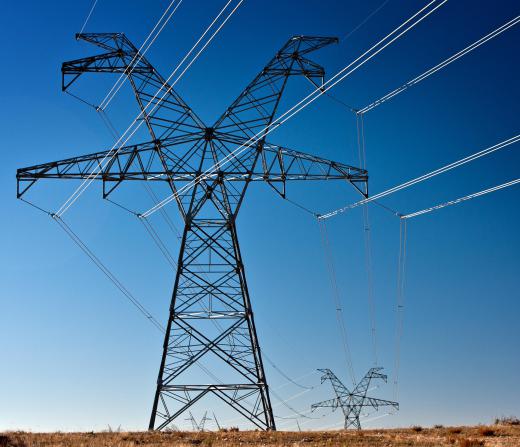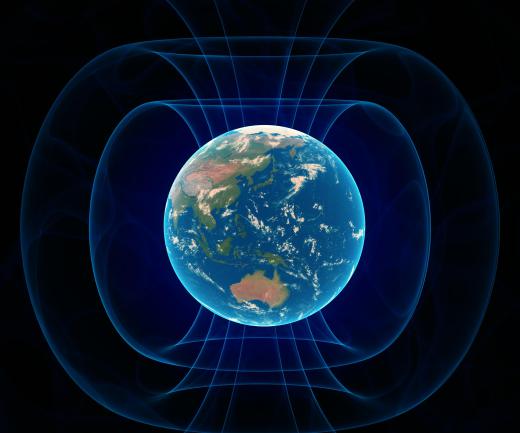What is a Solar Storm?
 Mary McMahon
Mary McMahon
A solar storm is an event in which activity on the Sun interferes with the Earth's magnetic field. Because the Sun is so far away, many people believe that these storms are not capable of causing very much damage, but they can in fact be quite devastating. Research in the early 2000s created a number of potential worst case scenarios that illustrated the destructive power of solar storms, including scenarios showing that powerful nations in the developed world could be brought to their knees for a decade or more by a storm of large magnitude.
Solar storms occur as a result of events such as solar flares and coronal mass ejections. These events generate a so-called “solar wind,” a gust of charged particles that can slam into the Earth's magnetic field in hours if the solar wind happens to be traveling in the direction of Earth. The collision can generate quite a light show as a geomagnetic storm erupts, and the storm can last for several days under the right conditions.

The most severe storm in recorded history occurred in 1859. Known as the Carrington Event, it caused electromagnetic disruptions all over the world, including auroras over the equator and the interruption of scientific devices that relied on the Earth's magnetic field to function properly. Lesser storms were also recorded in 1958, 1989, and 2000, and these events were associated with interruptions of the electrical grid and damage to satellites.

Concerns about solar storms revolve around their ability to disrupt electrical systems. A severe storm could effectively knock out the electricity grid across a large swath of the world, which would have very serious consequences, as it would be necessary to replace large portions of it. Storms can also disrupt communications and satellites, and they can be very dangerous for astronauts if they happen to be in the way of the solar wind.

A solar storm can also involve the introduction of tremendous amounts of radiation, which is dangerous for many living organisms. The disruption of the Earth's magnetic field can also be damaging. Some animals, for example, appear to be sensitive to magnetic fields and they could become disoriented in a storm.
Due to concerns about this phenomena, a number of agencies monitor solar activity for signs of events which could trigger a storm. Periodically, warnings or advisories may be issued to alert people to events that could cause disruption, such as interference with radio signals. In the event of a major storm, however, there is little that could be done to prepare or prevent damage.
AS FEATURED ON:
AS FEATURED ON:














Discussion Comments
How do we know about solar storms?
What are the different types of solar storms, though?
What is a solar flare?
@ Fiorite - I would like to point out that the impact could be a little worse for some countries and companies than others. The true impact will depend on how aggressively governments and companies adopt protective measures for their infrastructure.
Launching satellites is expensive, and the heavier the satellite, the costlier the launch. It can cost $5,000 or more to launch a single kilogram of material into space. Whether the material being launched is millions of dollars of sensitive equipment that provides the foundation for our technology infrastructure, or a $100 of dead weight meant to shield against radiation has no effect on the cost. Companies and governments have to find an acceptable balance between investment protection, and their bottom line. For companies in competitive industries (like communications), shielding against radiation may take a back seat to profits.
Probably the most important thing anyone can do is to have an emergency plan in place. In case the worst case scenario of a two month long interruption of basic services should occur, you should have basics like non-perishable food, water, a little cash, a first aid kit, and a couple weeks worth of medications. A large solar storm will not stop the world from turning, but things like phones, computers, credit cards, and some forms of mass transportation will be temporarily useless.
@ Amphibious54 - Solar storm cycles are somewhat predictable simply because they follow solar activity patterns. Patterns of solar activity happen in cycles which run approximately 11 years. The last solar maximum was the summer of 2000, while current predictions for the next solar maximum are for sometime around March 2013. This can give governments and private companies some time to prepare their infrastructure for solar radiation events.
Although solar storms will inevitably cause some infrastructure damage, some of this damage can be mitigated. Gas pipelines are built to take into effect electromagnetic corrosion; preventing breakages and explosions from intense electromagnetic fields. Satellites are shielded from radiation, and the amount of shielding should take radiation from solar flares and wind into their operational life cycle. Putting some satellites in a standby mode when they pass through waves of solar radiation and altered electromagnetic fields can also help to avoid navigational problems. Governments and civilians will have some notice that there is a solar flare sending radiation in our direction; allowing for the necessary precautions to be taken. However, is there a worst case scenario? The short answer is yes.
Is there any way to predict when a solar storm will strike? It seems like the more technologically advanced society gets, the worse the effects of a solar storm will be. One would almost think that solar storms were some sort of doomsday phenomenon that could permanently alter life as we know it. Is there any type of plan in place to deal with a solar storm if one should occur? If there is no plan in place are we doomed to the fate of a technological reset like the one that was feared at the turn of the century (anyone remember Y2K)? The fears of a solar storm seem a little exaggerated to me, but maybe it's because I do not know enough about them.
Post your comments